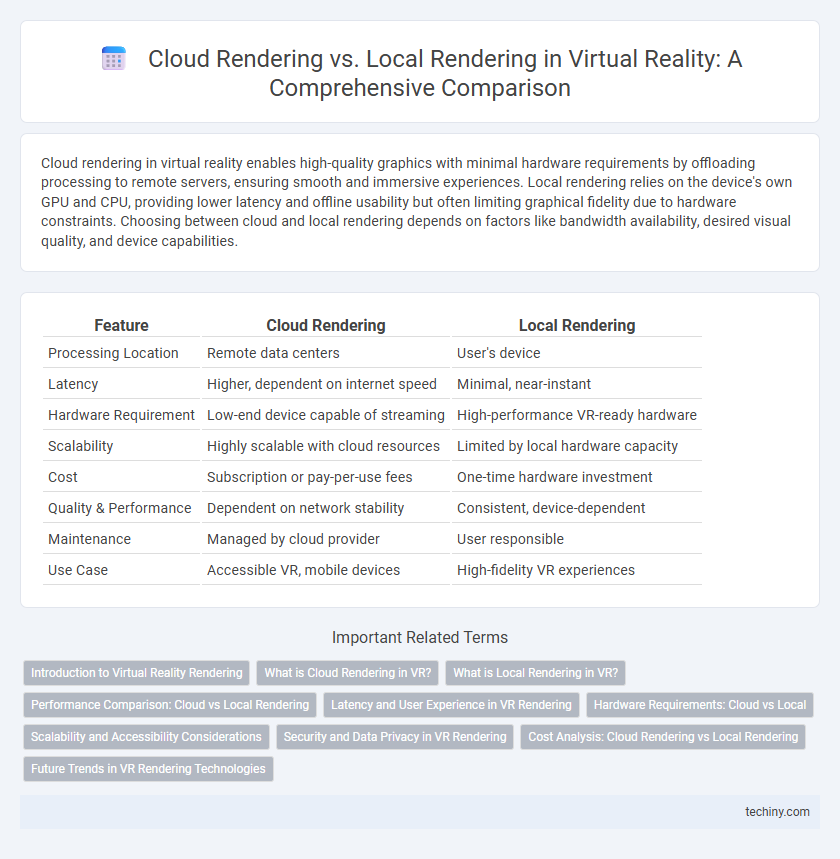Cloud rendering in virtual reality enables high-quality graphics with minimal hardware requirements by offloading processing to remote servers, ensuring smooth and immersive experiences. Local rendering relies on the device's own GPU and CPU, providing lower latency and offline usability but often limiting graphical fidelity due to hardware constraints. Choosing between cloud and local rendering depends on factors like bandwidth availability, desired visual quality, and device capabilities.
Table of Comparison
| Feature | Cloud Rendering | Local Rendering |
|---|---|---|
| Processing Location | Remote data centers | User's device |
| Latency | Higher, dependent on internet speed | Minimal, near-instant |
| Hardware Requirement | Low-end device capable of streaming | High-performance VR-ready hardware |
| Scalability | Highly scalable with cloud resources | Limited by local hardware capacity |
| Cost | Subscription or pay-per-use fees | One-time hardware investment |
| Quality & Performance | Dependent on network stability | Consistent, device-dependent |
| Maintenance | Managed by cloud provider | User responsible |
| Use Case | Accessible VR, mobile devices | High-fidelity VR experiences |
Introduction to Virtual Reality Rendering
Virtual Reality rendering relies on transforming 3D models into immersive visuals, achieved through cloud rendering or local rendering techniques. Cloud rendering utilizes remote servers with high computational power to stream VR content, offering scalability and reduced device hardware demands. Local rendering processes VR environments directly on the user's device, ensuring low latency and higher control over graphics quality, essential for real-time immersion.
What is Cloud Rendering in VR?
Cloud rendering in VR involves processing and generating high-quality virtual environments on remote servers, then streaming the rendered content to a user's device in real-time. This approach leverages powerful cloud GPUs, reducing the local hardware requirements and enabling access to complex VR experiences on lightweight headsets. Cloud rendering enhances scalability, allowing multiple users to experience rich, immersive graphics without the latency and performance limitations of local rendering.
What is Local Rendering in VR?
Local rendering in VR refers to the process where the device itself, such as a VR headset or connected computer, handles all the graphic computations and image generation without relying on external servers. This method reduces latency and provides a more responsive and immersive experience by minimizing dependence on network speed or cloud infrastructure. Local rendering requires powerful hardware to process high-resolution VR environments in real-time, ensuring smooth performance and visual fidelity.
Performance Comparison: Cloud vs Local Rendering
Cloud rendering leverages powerful remote servers to process complex VR graphics, enabling higher frame rates and seamless scalability compared to local rendering, which relies on the limited GPU and CPU capacity of user devices. Latency remains a critical factor in cloud rendering; however, advancements in edge computing and faster 5G networks have significantly reduced input lag, narrowing the performance gap with local rendering. Local rendering provides consistent low-latency experiences but may struggle with high-fidelity graphics without expensive hardware upgrades, making cloud rendering a cost-effective alternative for intensive VR applications.
Latency and User Experience in VR Rendering
Cloud rendering in VR significantly reduces local hardware constraints but introduces latency due to data transmission over the internet, impacting real-time responsiveness and potentially causing motion sickness. Local rendering offers minimal latency by processing graphics directly on the VR device, enhancing user immersion and ensuring smoother interactions. Optimal VR experiences balance latency-sensitive tasks with cloud resources, leveraging edge computing and high-speed networks to mitigate delays.
Hardware Requirements: Cloud vs Local
Cloud rendering in virtual reality significantly reduces hardware requirements on the user's end by offloading complex processing tasks to powerful remote servers, enabling high-quality VR experiences on lightweight devices. Local rendering demands high-performance GPUs, ample RAM, and fast CPUs within the VR headset or connected PC, increasing cost and energy consumption. Cloud rendering supports scalability and accessibility, allowing users with lower-tier hardware to access advanced VR content without frequent upgrades.
Scalability and Accessibility Considerations
Cloud rendering in virtual reality offers exceptional scalability by leveraging distributed computing resources, enabling seamless performance upgrades and supporting multiple users simultaneously without hardware limitations. In contrast, local rendering depends on the VR device's processing power, restricting scalability and often leading to inconsistent performance across different hardware configurations. Accessibility is enhanced through cloud rendering since users can access high-quality VR experiences on less powerful devices, whereas local rendering requires significant investment in high-end hardware, limiting widespread adoption.
Security and Data Privacy in VR Rendering
Cloud rendering in virtual reality offers scalable processing power but introduces potential security risks due to data transmission over the internet, increasing vulnerability to unauthorized access and breaches. Local rendering processes VR data on-premises, significantly reducing exposure to cyber threats and ensuring better control over sensitive information. Enterprises prioritizing data privacy often prefer local rendering solutions to maintain compliance with stringent security regulations and protect user identities.
Cost Analysis: Cloud Rendering vs Local Rendering
Cloud rendering in virtual reality significantly reduces upfront hardware investment by leveraging scalable remote servers, resulting in lower initial costs but recurring subscription fees based on usage. Local rendering demands high-performance VR-capable machines with substantial GPU power, leading to higher capital expenditure yet minimal ongoing costs. Cost analysis reveals cloud rendering optimizes operational expenses for fluctuating workloads, whereas local rendering suits consistent or heavy use, minimizing long-term cloud service fees.
Future Trends in VR Rendering Technologies
Cloud rendering in virtual reality leverages powerful remote servers to deliver high-quality graphics with minimal hardware constraints, enabling more immersive experiences on lightweight devices. Local rendering continues to evolve with advancements in GPUs and edge computing, allowing for reduced latency and offline accessibility in VR applications. Future trends indicate a hybrid approach, combining cloud scalability with local processing to optimize performance, reduce latency, and enhance graphical fidelity in VR environments.
Cloud rendering vs Local rendering Infographic

 techiny.com
techiny.com